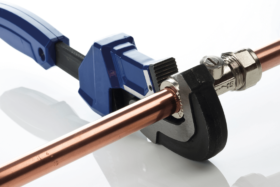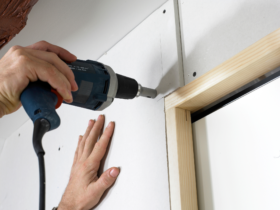
Learn from the experts TONIGHT with our online training course!
Use the code BUILD for 20% off
Learn from the experts TONIGHT with our online training course!
Use the code BUILD for 20% offAny really dramatic changes in the landscape and ground levels are best tackled when you have the heavier machinery for the groundworks on site. If you can, prioritise the landscaping deisgn and earth-moving works from the start of your self build – you don’t want to get to the end of your project and find you have a gardening nightmare on your hands! However, even once the large plant has gone, there are still some very effective landscaping tools that will get the job done.
You might end up buying some of these yourself for ongoing maintenance, while other landscaping tools are best hired on a day rate. Here’s what you need to know.
The mini excavator is the most popular of the heavy landscaping tools that can tackle in hours what would take days to accomplish manually. These 1.5-tonne machines can dig down to a maximum depth of 2m and have a ground-level reach of over 3m, making them perfect for trench digging, excavating a pond or heaping up earth to form a bank.
There are now even narrow track mini excavator machines on the market that are less than 1m in width. The secret is to manage the groundworks and landscaping as one project to ensure the entire heavy digging work is done in one hit.
Familiarise yourself with the controls before even attempting the work and always make sure you have read and understood the safety instructions – these machines can tip over. Hire prices start from around £100 for a day but you will probably find that the rate for one week is a good investment and will save you a lot of backbreaking work. You can also ask for a breaker attachment for an additional £80.
Once you’ve dug up all that earth, you need some way of moving it. Mini dumpers are mechanised wheelbarrows that use a four-wheel drive set up and, at 700mm wide, can be squeezed though a standard doorway or narrow side alley. The machines can tackle a 20° slope and come with a tough steel skip.
Most carry around three full wheelbarrow loads, or 150 bricks, so you can work out your time/costs from that. Mini dumpers can be ordered with a skip-loading ramp, flatbed and several other handy accessories. You may decide it’s actually worth buying a dumper for a large-scale project (they cost around £2,250) and selling it on afterwards. The other option is to hire it – one weekend costs around £88.
Even with all the muscle of motorised machinery, there’s always a need for a plain old wheelbarrow. All gardeners need a strong wheelbarrow with a wide pneumatic wheel that won’t create ruts in your newly laid lawn.
Look for a hod that’s either galvanised to prevent rust or made of thick plastic. Painted steel versions are the cheapest. Depths and hod shapes vary, giving a load capacity of 80 to 125 litres.
Top-of-the-range models even have safety guards on the handles to protect your knuckles from brushing against trees and other obstacles. Prices start at around £30.
One of the less popular items on the hire market, the compact skid steer is still well worth considering for heavy landscaping duty. It can tackle lifting, carrying, digging and levelling, and the auger attachment can drill out post holes down to 1,200mm.
A combination skid steer machine is never as good as a purpose-made tool (it can’t dig deep trenches, for example), but the skid steer is easy to control, as long as you don’t mind standing on the footplate all day. Hire costs from about £106 a day.
Once you have the ground shapes established, a rotivator or light-duty tiller can be used to break up the clods and prepare the soil for planting or turfing.
Hire a lightweight tiller for cultivated or broken-up soil, or a heavier rotivator for breaking up compacted earth. Rotivator and tiller hire costs start at around £30 for a single day.
It’s very likely you’ll want to add some new fencing, screening or timber structures, such as arches or gazebos, to your new plot. Post-hole borers are the best landscaping tools for this job.
There are several post-hole borers available, depending on the size of the project. For small-scale work, a manual shovel holer, available to buy from around £30, can form neat holes with its scissor action.
You could also use a manual auger borer to make the initial hole. Manual tools are fine for smaller holes but for anything over about 500mm, a powered machine is the answer. Two-stroke, single-person operated manual auger borers cost around £50 for a day’s hire.
Finally, there is the ultimate hole digger – the hydraulic borer. These machines can create holes up to 230mm wide and 850mm deep and cost about £125 for a weekend’s hire.
To keep your newly laid lawn looking immaculate, choose a cylinder mower. The bank of blades rotate to chop cleanly through the grass, unlike the hacking and tearing action of other mowers. These blades must be kept sharp to work well, so regular maintenance is important.
Cylinder mowers don’t work well on rough areas or long grass but are good for the keen gardener who wants to give the front of his new plot kerb appeal. The clean cutting action and cylinder design is best for cutting right up to walls or fences. Look for five blades rather than the standard four if you’d like the ultimate lawn.
If you have some less clipped areas to maintain, go for a hover mower. The motor drives a fan to keep the machine just off the ground, allowing it to work over rough terrain. These mowers don’t rely on rollers, but instead use the motor to drive a powerful fan, forcing air downwards and allowing the machine to hover over the grass.
They don’t have wheels and rollers so are the lightest choice – go for a hover if you have a steeply sloping or awkwardly shaped plot. Cutting isn’t as good over long grass or very uneven lawns as the hover action can cause the blades to ‘dig in’ to low spots. Some can compact the stored cuttings so there’s less time wasted unloading. Opt for at least a 1,200W machine for medium to large lawns.
Finally, the machine that combines some of the benefits of cylinder and hover is the rotary mower. If you have a large plot that isn’t going to be mowed often, a rotary with four wheels will cope well with the long grass.
For lawns up to around 250m2, an electric version with around a 400mm cut width is fine. If you have a larger plot, go for a petrol model with a self-propelled rear roller to make the job easier, especially for sloping sites. The back roller will also form the neat striped effect on formal lawn areas.
Ride-on rotary mowers are an expensive option but worthwhile if you have an acre or more to cut, although mini versions are sold for half-acre plots. Most have mulching and collection accessories and cutting widths go from around 90 to 140cm. You should look for an engine of at least 15hp for the smaller models. Prices start from around £1,100.
Although most of us own loppers and secateurs, you may need to hire long-reach pruners to tackle overhanging tree branches. Always call in a professional for larger-scale work, as chainsaws are not like any other piece of hire equipment – users should attend a safety course and need specialised safety equipment.
Telescopic loppers reach up to around 5m and the electric or petrol powered versions use a mini-saw to slice through the branch – much less tiring and quicker than operating a manual lopper.
If you’re redesigning a garden, turf may need to be removed or laid. Hiring a turf stripper for around £100 per weekend is the easiest and most efficient way. Petrol-engined machines able to remove 300mm-wide strips of turf at the rate of up to 500m per hour; the grass can then be re-laid elsewhere, saving you the cost of buying it in.
There’s no quicker way of dealing with rough areas of a plot than using a brush cutter. Electric models are fine for small gardens but tend to stall when faced with long grass or thick-stemmed weeds. About £120 to £200 will buy a decent petrol line trimmer.
Look for bicycle handle controls and a thick padded shoulder strap. The business end should feature a metal blade and auto-line feed for continuous use without having to stop to adjust the line. Petrol versions weigh around 5kg.


Comments are closed.